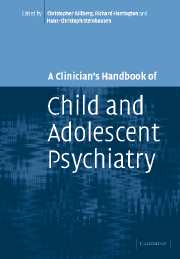Book contents
- Frontmatter
- Contents
- Preface
- List of contributors
- 1 Brain disorders
- 2 Substance use disorders
- 3 Schizophrenia and schizophrenia-like disorders
- 4 Affective disorders
- 5 Anxiety disorders
- 6 Obsessive-compulsive disorders
- 7 Adjustment disorders
- 8 Post-traumatic stress disorder
- 9 Functional somatic symptoms and somatoform disorders in children
- 10 Eating disorders: anorexia nervosa and bulimia nervosa
- 11 Sleep disorders
- 12 Personality disorders
- 13 Mental retardation/learning disability
- 14 Specific developmental disorders of speech and language
- 15 Reading and other learning disorders
- 16 Autism spectrum disorders
- 17 Hyperkinetic disorders
- 18 Conduct disorders
- 19 Elective mutism
- 20 Attachment and disorders of attachment
- 21 Tic disorders
- 22 Elimination disorders: enuresis and encopresis
- 23 Physical and sexual abuse
- 24 Gender identity disorders
- Index
- References
20 - Attachment and disorders of attachment
Published online by Cambridge University Press: 06 August 2009
- Frontmatter
- Contents
- Preface
- List of contributors
- 1 Brain disorders
- 2 Substance use disorders
- 3 Schizophrenia and schizophrenia-like disorders
- 4 Affective disorders
- 5 Anxiety disorders
- 6 Obsessive-compulsive disorders
- 7 Adjustment disorders
- 8 Post-traumatic stress disorder
- 9 Functional somatic symptoms and somatoform disorders in children
- 10 Eating disorders: anorexia nervosa and bulimia nervosa
- 11 Sleep disorders
- 12 Personality disorders
- 13 Mental retardation/learning disability
- 14 Specific developmental disorders of speech and language
- 15 Reading and other learning disorders
- 16 Autism spectrum disorders
- 17 Hyperkinetic disorders
- 18 Conduct disorders
- 19 Elective mutism
- 20 Attachment and disorders of attachment
- 21 Tic disorders
- 22 Elimination disorders: enuresis and encopresis
- 23 Physical and sexual abuse
- 24 Gender identity disorders
- Index
- References
Summary
Introduction
The modern story of attachment began soon after World War II, when John Bowlby (1907–1990) and Rene Spitz (1887–1974) independently began to document the fate of children separated from their parents, reared from infancy in orphanages, or placed in traumatic circumstances in institutions where care might be efficient but impersonal. What they found is familiar to us now: listless, apathetic children who had not had personal attention from an interested adult, and disinhibited, over-friendly children who made shallow relationships with any adult who passed through their world. John Bowlby's contribution to our understanding of child development was his perception that ‘mother love’ had evolutionary value, and that some behaviours that young children show with their parents might be biologically determined to support survival. Bowlby was no biological determinist, however, and fully recognized the importance of the quality of parental care and the potentially harmful effects of its loss early in life. His theory of attachment proposed that the need for safety is an organizing system in the psychosocial development of children, and that this is different and separate from the need for food or sex. The theory posits both innate characteristics, determined by evolution, and a continuing effect of the experienced environment on the developing child.
Two strands have run through the work that has followed Bowlby's original ideas, developmental and clinical.
- Type
- Chapter
- Information
- A Clinician's Handbook of Child and Adolescent Psychiatry , pp. 573 - 597Publisher: Cambridge University PressPrint publication year: 2006
References
- 1
- Cited by



